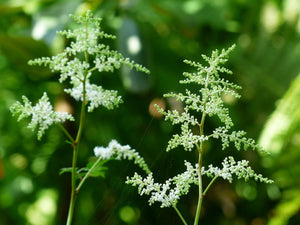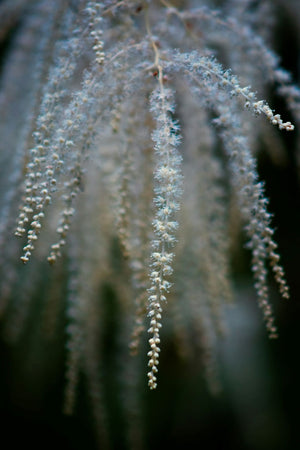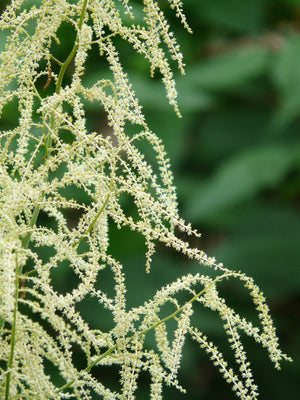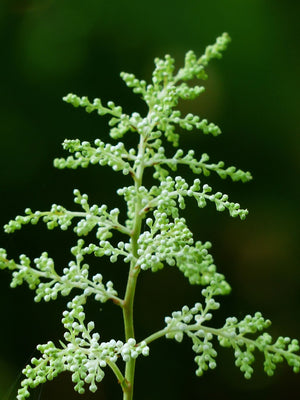The Aruncus Guide
Aruncus, commonly known as Goat's Beard, brings a touch of elegance and grandeur to any garden landscape. With its feathery, plume-like flowers and lush foliage, Aruncus plants are perfect for adding vertical interest and texture to borders, garden beds, and naturalistic plantings. These plants are admired for their ability to thrive in a variety of conditions and their minimal maintenance requirements. Whether you're aiming to enhance your flower garden, create a dramatic display, or add a unique element to your space, Aruncus offers a captivating and versatile solution. Explore our Aruncus Guide to learn more about cultivating and caring for these fascinating plants, and discover how to incorporate them into your garden for lasting beauty and enjoyment.

About Aruncus
Aruncus is a small genus of flowering plants in the Rosaceae family, comprising three species. These plants are native to the temperate regions of the Northern Hemisphere, including North America, Europe, and Asia. The name "Aruncus" is derived from the Greek word for "goat's beard," referring to the plant's feathery, plume-like flowers.
Aruncus plants are characterized by their large, compound leaves and tall, feathery plumes of small, creamy-white flowers that bloom in late spring to early summer. The flowers are borne on tall, sturdy stems, creating a striking visual effect in the garden. The foliage is equally attractive, with finely divided, fern-like leaves that remain lush and green throughout the growing season.
Some popular species and varieties of Aruncus include Aruncus dioicus (Common Goat's Beard), Aruncus aethusifolius (Dwarf Goat's Beard), and Aruncus 'Kneiffii' (Cutleaf Goat's Beard). Each species has its unique characteristics, but all share the common traits of beautiful flowers and easy care.

Planting Aruncus
Aruncus plants require specific planting conditions to ensure their successful establishment and flourishing growth. Here are some essential guidelines for planting and caring for Aruncus:
Soil: Aruncus prefers well-draining soil that is rich in organic matter. A loamy or sandy soil works best. Ensure the planting site is free from heavy clay or waterlogged conditions, which can cause root rot.
Light: Aruncus thrives in partial to full shade but can tolerate some morning sun. Choose a location with filtered sunlight or dappled shade for optimal blooming. In hotter climates, more shade is beneficial to protect the plants from intense heat.
Watering: Aruncus requires regular watering during the growing season to keep the soil evenly moist but not waterlogged. Once the plants are established, they are relatively drought-tolerant. Reduce watering in the winter months when the plants are dormant.
Planting Depth: Plant Aruncus at the same depth as it was growing in its pot or nursery container. Space the plants 18-24 inches apart to allow for proper air circulation and growth.
Mulching: Apply a layer of organic mulch, such as compost or shredded leaves, around the base of the plants to retain moisture, suppress weeds, and regulate soil temperature. Avoid covering the crowns directly, as this can lead to rot.

Care for Aruncus
Aruncus plants require specific care to ensure their optimal growth and health. Here are some general guidelines for the care of Aruncus:
Watering: Keep the soil consistently moist during the growing season but avoid waterlogging. Water the plants deeply, allowing the soil to dry out slightly between waterings. Once the plants are established, they can tolerate periods of drought.
Fertilizing: Aruncus benefits from a balanced, slow-release fertilizer applied in the spring as the plants begin to grow. Follow the recommended dosage on the product label. Avoid over-fertilizing, as this can lead to excessive foliage growth at the expense of flowers.
Pruning: After the flowers fade, you can trim back the spent flower stalks to maintain a tidy appearance and encourage bushier growth. Allow the foliage to die back naturally in the fall, as this process helps the plants store energy for the next growing season. Avoid cutting back the leaves too early.
Pests and Diseases: Aruncus is relatively pest-resistant but can be susceptible to issues such as powdery mildew and rust. Inspect your plants regularly and treat any infestations promptly with appropriate organic or chemical controls. Maintain proper spacing and air circulation to reduce the risk of diseases.
Dividing: Aruncus plants can become crowded over time. Divide and replant the clumps every 3-4 years to maintain healthy growth and prolific blooming. The best time to divide Aruncus is in the spring before new growth begins or in the fall after flowering.

How to Use Aruncus
Aruncus offers versatility and can be utilized in various ways to enhance your garden spaces. Here are some recommendations based on their characteristics:
Borders and Beds: Aruncus's tall, feathery plumes and lush foliage make them ideal for adding vertical interest and texture to garden borders and flower beds. Plant them in clusters or drifts for a dramatic display of color and form.
Pollinator Gardens: Aruncus flowers attract pollinators such as bees and butterflies, making them a valuable addition to pollinator gardens. Plant them alongside other pollinator-friendly plants to create a thriving ecosystem that supports local wildlife.
Cut Flower Arrangements: Aruncus blooms make stunning additions to cut flower arrangements. Harvest the flowers when they are fully open and use them in bouquets, centerpieces, or floral displays to bring the beauty of the garden indoors. Their long-lasting flowers add a touch of elegance to any arrangement.
Naturalistic Plantings: Aruncus's ability to thrive in various soil types and light conditions makes them well-suited for naturalistic plantings and woodland gardens. Plant them among native grasses and wildflowers to create a low-maintenance, natural-looking landscape.
Seasonal Displays: Use Aruncus in seasonal displays to bring bright color and texture to your garden from late spring to early summer. Their long-lasting blooms and resilience make them a reliable choice for extended seasonal interest.
Containers: Dwarf varieties of Aruncus can be grown in containers, making them a versatile choice for patios, balconies, or small gardens. Plant them in pots or containers and place them in shaded spots to enjoy their blooms up close.
Conclusion
Aruncus is a captivating and versatile addition to any garden landscape. With their feathery plumes, lush foliage, and minimal maintenance requirements, Aruncus plants bring a touch of elegance and grandeur to your environment. Their adaptability to various growing conditions and ease of care make them a favorite among gardeners of all levels. By following proper planting and maintenance techniques, you can fully harness the potential of Aruncus to enhance your garden, creating a lasting impact.
Whether you seek to create stunning flower displays, enhance your garden borders, or add visual interest to naturalistic plantings and containers, Aruncus can fulfill a variety of roles in your landscape design. Place them individually to highlight their unique blooms, or cluster them together for a striking visual display. Aruncus's resilience and adaptability also make them ideal for pollinator gardens and seasonal displays.
Beyond their ornamental value, Aruncus plants attract beneficial pollinators and contribute to the biodiversity of your garden ecosystem. With their enduring beauty, versatility, and ecological significance, Aruncus plants bring delight and natural allure to your outdoor environment, enriching your gardening experience and enhancing the overall beauty of your landscape.

